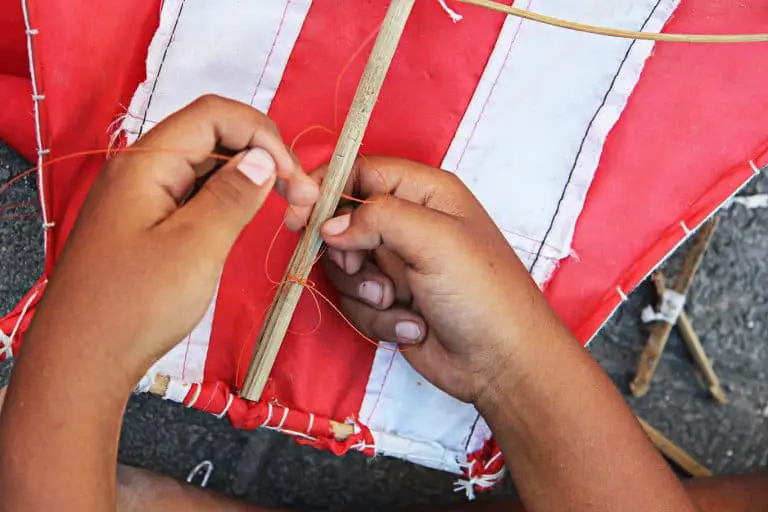Kites: Are They Waterproof?
One of the biggest factors that can affect the longevity of a kite is exposure to water. If you fly kites, it only makes sense to wonder if there are waterproof kites. This article will discuss whether or not kites are waterproof and some of the best methods to make your kites water-repellant.
Some kites may be waterproof, depending on the materials for the purpose they serve. An example is Kitesurfing. Since you’re flying the kites close to water, it only makes sense for them to be waterproof.
If you love to fly your kite at the beach, then you know there is a high chance of your kite landing on water. It doesn’t have to ruin your kite; you can easily get rid of the worries of extra costs or damages with a waterproof kite.
Waterproof kites are made with materials that make them safer to ride and lighter to carry and contribute to better control in and out of the water.
However, note that although flying a waterproof kite in the rain can reduce its exposure to the elements, it does nothing to protect you and your kite from lightning.

What Are The Benefits Of A Waterproof Kite?
There are many benefits to be enjoyed from flying a waterproof kite, especially as a kitesurfer. These benefits include, but are not limited to:
- Improves the kite’s gliding behavior
- Reduces friction as the kite glides through the air
- Repels water and, sometimes, dirt
- Less water absorption means less weight, reduced drying time, and reduced space requirement.
- Reduces the risk of stain and mold formation on the kite
- Promotes the kite’s durability
- It reduces permeability and improves the aerodynamics of the kite
- It increases the breaking load of the kite without the need to increase the fabric weight
For What Are Waterproof Kites Useful?
Even though we do not recommend flying a kite under the rain, there are several wet conditions where flying a waterproof kite may come in handy. For example, if you’re flying your kite close to any body of water, you need a waterproof kite.
Have You Ever Heard Of “Kitesurfing”?
Kitesurfing is a high-risk sport involving the use of kites. The kite user makes use of a big power kite propelled by the wind to be pulled on water or snow surfaces. (Source)
High-risk sounds scary at first read, but it poses no higher risk than your everyday sport. The idea of being strapped in a tight waist harness on a surfboard while being pulled by a giant kite flying as high as 20 meters might sound dangerous or impossible, but it isn’t.
Kitesurfing belongs to the least expensive class of sailing sports. It combines different aspects of surfing, snowboarding, and windsurfing into one sport, including racing competitions, wave riding competitions, and freestyling.
This sport was invented in the late 1970s but didn’t correctly come into the limelight until the late 1990s. However, the entire evolution of Kitesurfing didn’t happen until the 20th century. Kites have been improved and developed into more stable builds giving the flyer better control. Such improvements include the “4-lines design” and the “depower function.”
Since Kitesurfing involves water, the best kites for this sport need extreme, waterproof abilities. The best suitable kite for this purpose is the Power Kite. (Source)
Power Kites
A power kite is a large type of kite designed to give its user a significant amount of pull. They can be used together with a vehicle or snowmobile for snowboarding or a board for Kitesurfing.
Power kites are usually waterproof. The two most known types of power kites are the leading edge inflatable kite and the foil kite.
Leading Edge Inflatable Kite (LEI)
The leading edge inflatable kite is mainly made from a single type of fabric, such as the ripstop polyester. This fabric combines with inflated ribs and an inflated tubular leading edge. It is inflated with an air pump before surfing.
Their primary usage is for Kitesurfing, and this is because they can be relaunched from the water after a still period. The frame and structure are also retained and aren’t disturbed by the water.
There are four different types of leading-edge inflatable kites. They are the Delta kite, how kite, C-kite, and hybrid kite. These kites offer several benefits: easy relaunching, being safe for beginners, great for speed riding or cruising, completely waterproof, and floatable.
Foil Kite
Snow kiters use foil kites. They are also known as soft kites and can be efficiently powered up and depowered. They are durable and perfect for snow kiteboarding and training.
They are mostly fabric materials with air cells. There are two types of foil kites, the open cell kite, and the closed-cell kite. The open cell kites aren’t perfect for water usage because they can easily get soaked and deflate.
The closed-cell kite contains inlet valves. It allows the chambers to hold air. It will let it relaunch easily in the water and slow down the deflation rate. Compared to the LEI, they operate better in lighter winds and generate more than double the power. They also look longer and thinner.
Of What Is A Kitesurfing Kite Made?
The best kitesurfing kites consist of waterproof ripstop nylon and polyester. The polyester material is a great waterproof option because it is strong enough for a water sport and is less expensive. The only known downside is its tendency to rip up quite easily.
The ripstop nylon material combines nylon threads and other materials such as cotton or silk. Kites made from this material don’t rip up easily and can be strong and stiff or silky soft. This material is durable and is tear-resistant. The way it’s woven also prevents further tears in rare cases of rips and tears.
How To Make Your Paper Kites Waterproof
We know that waterproof kite builds use waterproof fabric, but what about those with paper kites? How do they get to fly their kites in wet conditions without worrying about ruining them?
You can make your paper kites waterproof by coating them with a water-repellent substance. Examples of such chemicals include wax and Shellac. (Source)
Waterproofing Your Kite With Wax
You will need regular candles or beeswax, a metal pot for dipping (optional), your paper kite, and a pair of tongs. (Source)
- Clean your paper kite to remove dust and grime.
- Lay it on the flat, clean surface and begin to rub your wax across the surface. Take care not to rub too hard or risk tearing the paper.
- You may need to repeat this several times across the same patch to ensure the wax sticks.
- Alternatively, melt the wax on a medium heat using a pot and quickly dip your paper using a pair of tongs.
- Use gentle heat (like a hairdryer on low) to warm and cure the wax. It ensures that the wax is spread evenly across the paper.
- As the wax seal begins to wear off, don’t forget to top it off to maintain its integrity.
Waterproofing Your Kite With Shellac
You will need about five oz. of pale Shellac, 1 oz of Borax, 1 pt of water, a deep tray or wide bowl, and a pair of tongs.
- First, create your drying area. Your Shellac waterproofed paper kite needs to hang to dry. However, Shellac can ruin flooring, so you need to pad the floor to prevent drops from reaching it. (Source)
- Pour the water into a pot and heat to an almost boiling point. Slowly add the rest of the ingredients one after the other, stirring until they’re completely incorporated.
- Use a sieve to strain out the byproducts and impurities and pour out the remaining solution in your bowl or tray.
- Use a pair of tongs to dip your paper kite into the solution and hang it to dry on a wire rack in your drying area.
Final Thoughts
Waterproof kites are in season and are perfect for water sports. You should not reduce your love for kites to flying in only dry conditions. You don’t have to worry about getting your kites wet and ruining them anymore.
A waterproof kite guarantees that you can enjoy maximum fun with your kites both on land and on water. So, either buy a waterproof kite or make a non-waterproof kite waterproof following our simple instructions above. And above all, have fun kiting!
Sources
- Martin A. Uman, All About Lightning: Why Did Benjamin Franklin Fly The Kite. (New York: Dover Publications, 1986)
- Steven JG Leeuwerke, Manimaran Sinnathamby and René Zellweger, “Kitesurfing — playing with water or with fire?” The Medical Journal of Australia 2016; 204 (8), DOI: 10.5694/mja15.01130
- “Kiteboarding” Wikipedia, accessed December 01, 2021, https://en.m.wikipedia.org/wiki/Kiteboarding
- Liu, Mihaela, Guanglin Xu, Jianan Wang, Xinwei Tu, Xinyou Liu, Zhihui Wu, Jiufang Lv, and Wei Xu. 2020. “Effects of Shellac Treatment on Wood Hygroscopicity, Dimensional Stability and Thermostability” Coatings 10, no. 9: 881. https://doi.org/10.3390/coatings10090881
- “How to Waterproof Paper,” WikiHow, accessed December 01, 2021, https://www.wikihow.com/Waterproof-Paper
- Amelia H. Fuller, “Modern Floor Care: Floor Waxes and Maintenance,” Extension Division, Virginia Polytechnic Institute 62(1986):10






